AV — Music and Video
There are essentially three possibilities to combine music and video, while at the same time avoiding the natural tendency for the visual image to predominate. Perhaps the simplest case is to let both elements run independently. This approach is found in clubs where a DJ and a VJ meet for one evening, or in contemporary music concerts where synchronicity is often avoided on æsthetic grounds. The second typical approach uses common cues and changes or contextual similarities as points of synchronization between the audio and visual levels. This is the typical situation in music videos or TV commercials. The third possibility is the most interesting for me. Here the video is part of the conceptual strategy of an audiovisual composition.
There are many ways to integrate video directly into the compositional process. In my audiovisual compositions since 2000, I have limited myself to videos that show the musicians playing the piece (the music theatre pieces are an exception). When I use prerecorded videos, I see these, together with any prerecorded audio material, as a documentation of the piece’s development. The players are drawn into the compositional process. In the performance these images of an earlier stage in the work’s development reference the past thereby transporting the audience out of the concert environment into another space and a different situation. The relationship between the prerecorded material and the material played live in concert is, in principle, already fixed at the time the video is shot. Each piece has a performance score as well as a score for the recording. If a new musician wants to play the piece, he as well as me have to go through this process anew. A piece with live video realizes this process in real time in the concert hall. Such compositions first take on a meaningful shape for the audience only during the performance. In both cases, the situation on stage and the temporal processes in the music play a pivotal role. The video images require a large surface for the projection and therefore intrude into the action on stage, however the video images also invite the listeners to project their expectations and thoughts onto them. The listeners see something in the video which they connect with a simultaneous action on the stage. The temporal processes in the live music are underscored by the doubling in the video. While listening to music, we move between remembering past events and predicting what will come next and somewhere out of this back and forth our sense of the present emerges. This sense of orientation can be both supported and disturbed by small, almost imperceptible inconsistencies. These discrepancies might resonate back into the concert hall. At the start of a process, musicians will be identified with their video doubles, but over the course of the piece they can split into independent personalities on the stage. Sound and image also interact in a similar manner. Here too there are long stretches of doubling between the video and the prerecorded sound, or between the live music and the video soundtrack. Then in the course of the piece the video and the soundtrack, or the soundtrack and the live music become decoupled, just when the listener has become accustomed to the synchronicity.
FAQ — Video
Why video?
From my point of view it is completely normal to employ electronic media these days. It is actually stranger that composers who work with new media are often asked why they do this, while composers who work exclusively with traditional instruments are not asked why they choose to do without new technology. The question “why video?” is really used as a smokescreen to avoid dealing with, on the one hand, the dismissive attitude of many concert presenters whose venues are not equipped for such pieces, and on the other hand the conservative nature of New Music, its core audience, and their arrested development, which never made it out of the 20th century. The composers also share a bit of the blame for this. All too frequently the excessive amount of equipment required and the ridiculous amounts of time and energy put into setting up a performance often bears little relation to the quality of the end result.
Is video the saviour of New Music?
It’s not uncommon for people to believe that using new media can make New Music easier to digest. That’s of course ridiculous. If the music doesn’t do its job, no video will be able to save it and if there is no clear concept how to combine the audio and video, then their fusion can only work thanks to the unfortunately often present good will and insecurity of the listeners.
Do composers have any business making videos in the first place?
In general, it’s a good idea to work with a video artist or a director or at least to get some advice from someone who knows what they’re doing. In my opinion, it would also be a good thing if composers and software specialists collaborated on the electronic parts of their music, especially when musical instruments are involved. Even in this area there are few people who have enough experience in both areas. Finally, most composers have a latent compulsion to micromanage everything, however in most cases this means they don’t pay enough attention to the music, and it’s really too bad that collaborative work is not so highly regarded.
Aesthetic Aspects
Before going into more detail about some of my compositions, I’d like to take a moment to make a few general remarks about my music. In the last century, the focus of composing, listening, and analysis in New Music shifted to the invention of new material and new structures. I want to categorically distance myself from this approach. In my opinion, it’s irrelevant whether it is even possible these days to invent new sound or forms, because audiences aren’t looking for this anyway. It seems like it would be much more important to bring some form of communication to the concert hall. A prerequisite for such a communication would be a new emphasis on the meaning of musical material and the development of appropriate compositional strategies. We also have to address and overcome the lack of consideration for the audience. In my view it’s high time that composers start seriously thinking about what is actually happening in the concert hall from every possible perspective. It seems pointless to try to avoid effects in music, if this means avoiding any sort of reaction from the audience. I believe it makes much more sense to take full advantage of the effect that music can have on listeners, but always keeping in mind that such approaches can fail and lead to misunderstandings. A break from the idea that composed music should only be viewed in structural terms is long overdue, and in my opinion the all too apparent crisis in New Music (as well as in the art scene in general) cannot be overcome by forced, hollow outreach efforts. The composers and their pieces have to change radically to address a situation in which there is, truth be told, no audience at all for art, and under such conditions no art is able to continue to exist. Even though concerts and exhibition are well attended, what’s happening there these days has nothing to do with art in its true sense. These are the perfect conditions for a fresh start. My suggestion is to create a forced communication in the concert situation by working with understandable musical meanings in the form of musical signs. Musical material (i.e. sounds) will of course still be used, however it will no longer be tantamount to the content of the music.
If the material is no longer chosen for its qualities per se, but rather for its meaning, this demands the use of borrowed (familiar) material. How else can the material already have a meaning? However, a contextual work has to go well beyond the now standard techniques of quotation and collage. It is of utmost importance to keep in mind that the quotation is not the material itself, but is rather the act of quoting that is the material for the composition. I am not interested in the original meaning that the quotation is loaded with, nor its possible new meanings in a new context. If one emphasizes the act of quoting (and not the quotation), then the quote itself plays a subordinate role and its meanings can more or less dissolve. For this purpose, the best sort of materials are ones that are typically characterized as loaded, overused, idiomatic and unambiguous. This kind of material is the first to lose its meaning in a musical context. Such quotations are forgotten as quickly as they are recognized. As soon as they are forgotten, they make way for the actual content of the composition: in this case the act of quoting. In order for the source of a quotation to be forgotten, it has to be used in a blatantly obvious way these days. And this has to be at least so obvious that the listener notices it. If this level isn’t reached, the presence of the quotation unfortunately will simply be misunderstood by the listeners. If it goes too far, this will also cause confusion and the end result will most likely not be much different than the in-your-face (pseudo-postmodern) style of quoting, or for that matter, than New Music in general, which is notorious for self-plagiarism.
The musical context of a performance is also very important for me. When I speak of the musical context, I don’t mean the physical place, but rather what kind of audience is likely to come to the concert, the musical environment, and the situation on the stage. It’s of course impossible to know exactly who will come to any particular concert. However, it is quite possible to form a reasonably accurate mental picture of the audiences for particular musical genres. In general, I think we should try to be a bit more crude in our manner of thinking. If you are expecting the typical New Music crowd, the piece’s strategy will have to be rough enough to make it clear to as much of the audience as possible so that the focus is not the structure. It’s no simple task to do this without slipping into platitudes, anyway it’s certainly more difficult than heaping yet another finely worked out pseudo-masterpiece on the pile. With the non-specialist audience, the composer, and the audience for that matter, have things much easier. The musical environment is closely linked to the audience anyway. In a heavy metal concert you will find music and people to match. New music is no different. It’s actually become quite easy again to be subversive in a New Music concert. But people simply don’t do it, after all it would of course not embarrass the parochial members of the audience, but it would expose the intellectuals as frauds. And if we ever reach the point that all composers have strayed from the pack and become courageous enough to challenge the status quo, then one has to change tactics and adapt to this new situation as well. Nothing lasts forever. And in my opinion, timeless as well as universally valid works of art only exists in our imagination anyway.
When I work with borrowed (familiar) material, I find it useful to differentiate between musical and extramusical connotations. Musical meanings have their origins in familiar music or reference well known musical effects, which include idiomatic playing techniques, passages (or even entire pieces) of different lengths and clarity from available music, sound constellations with predicable emotional effects (sadness, horror etc.), or structures that are associated with a typical musical context (a six-three chord at the beginning of a recitativo). Extramusical meanings are musical elements that listeners automatically connect with a non-musical phenomenon. Such material awakes similarly vivid associations or strong emotions. I mean for instance things such as jingles, signals, alarms, but also the French overture or the soldier’s march. Aside from these, there are also sounds and passages which tend to have somewhat vague meanings (scales) or others which are more concrete (the dinging of the microwave) and therefore react differently in a musical context. The boundaries are of course fluid and a combination of Liszt’s Les préludes and Lady Gaga will resolve itself differently than mixing a 9‑8 suspension with a police siren. For me, the crucial elements of a composition are that musical meanings are present, how they disappear, when they disappear, and why they disappear. The principal factors for the listener are when he becomes conscious of them, and if they disappear. My goal is to write pieces that allow distinctive material to emerge and then disappear (without hiding it), but not in any sort of musical structure or artificial context. My criteria for success are not related to how well constructed or novel structures are, but rather have more to do with the strategic handling of meanings. Such music naturally demands a different mode of listening, but only for people who are used to listening for structure.
FAQ — Borrowed Materials
Is working with borrowed (familiar) materials still art?
No, and it isn’t trying to be. The idea of art as a mystical art of creation is a resilient fairy tale from the 19th century. Today this conception of art only serves to mask many artists’ willing ignorance of their audience.
Is working with borrowed (familiar) materials a symptom of a lack of creativity and laziness?
No, in fact the opposite is true. Inventing new material and novel structures has become boring. The critical factor should be what happens between the music and the listener in the concert hall. And that depends on the strategy of the composition and on how accessible it is for the listener.
Does working with borrowed (familiar) materials lead to music which is too agreeable?
No, the idea that “pleasing” or “accommodating” is a negative musical criteria is simply polemical. Both of these should be thematized in music and themselves be used as material. Presently this is an important topic outside of the field of music. Whether a piece of music is popular or widely marketed says nothing about its quality. Every kind of music can be considered pleasing. This just depends on the point of view.
Is the artist allowed to think about the audience?
Yes, and in doing so this doesn’t have to revolve around calculating the level of success that the work will enjoy or giving the audience what they expect. The point is simply not to ignore the fact that there is an audience present. Many people are happy to forget this. And there is nothing stopping us from working with expectations in a composition. There are of course a myriad of other possibilities between fulfilling expectations and totally avoiding them.
Is working with borrowed (familiar) materials theft of intellectual property?
No, in my view there is no such thing as “intellectual property”. Culture is a common good that grows out of society, and therefore no one can claim to be the sole inventer of a melody or a compositional technique. It would be possible to deal with this issue in a much more relaxed and, most importantly, more nuanced manner than is presently the case. Patents and music copyright licensing organisations (like SOCAN, ASCAP, BMI and GEMA) only really protect the marketing of ideas. And that is legitimate. The process of copying in all its various forms has become an essential part of production in a wide range of fields. The act of copying should be thematized and used as material for musical compositions.
Die Zwei (2004), for flute, piano, tape and video
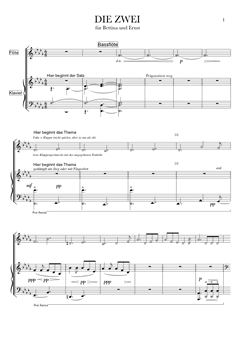
Die Zwei is an attempt to make music indistinct / blurry in order to see what the consequence / reaction will be in the concert hall. This experiment is an extreme case, because the source material’s harmonic and temporal characteristics remain unaltered. In a sense this makes the piece a kind of adaptation of pop art to music.
There were three good reasons for the choice of the slow movement of the Beethoven String Quartet 16 in F major op. 135: first of all it is especially scandalous to use such a revered piece, it was also well suited to the planned compositional process, and finally the piece just blows me away. I wanted to paint a copy or make a print of this quartet movement so that it would become indistinct behind the musical layers, but at the same time a clearly recognizable image of it would still shine through. What I really mean is a combination between the mechanical process of printing and the more intuitive process of copying a painting brush stroke by brush stroke. Every musical detail is transferred / converted onto other musical materials, so that in the end only the Beethoven itself is still there, but its meaning has been lost. The source material is not altered but it is nevertheless destroyed. And the Beethoven no longer has its usual meaning and an eerie vacuum of estrangement and alienation emerges. In Die Zwei, Beethoven’s quartet movement is not put in a different light, nor are we given a new way to experience the music; the harmony, the melody, and the form are all there, but the familiar is gone. This can have an uncanny quality to it — something that touches you in a totally different way from the original, maybe even in an uncomfortable way. I wasn’t interested in making an arrangement, but rather an estrangement from the estrangement that Beethoven’s music already embodies.
Here is how I went about making the piece: there are five layers, one of which is the video. The composition is derived exclusively from the strategy described above and in practice the mixdown of the individual layers.
For layer 1, a pianist and a flutist played an arrangement of the piece for flute and piano at five times the original tempo and a film was made of this. Next the video was played back at one fifth the speed using the “turtle” function in iMovie with its (even for that time) super cheesy time-stretching algorithm. On top of this, the video is a double mirror image. For the recording the players switched their positions so that when the video is played backwards in the concert, it appears as if the players in the video are positioned correctly, however the lid of the grand piano and the high pitches on the keyboard are on the wrong side.
Layer 2 consists of ten versions of the quartet modified to match the length of the version by the Alban Berg Quartet and played back simultaneously. In the beginning and at the end, the ten versions are relatively well synchronized and in the middle less so. The most compelling points were those where, by chance, several versions came together creating a certain sharpness for a fleeting moment.
Layer 3 is a retrograde version of the quartet played by the pianist (Ernst Surberg) which is, as before, played back in reverse.
For layer 4, the individual parts of the entire quartet movement were played by the flutist. The cello part was, however, played on the piccolo at four times the original tempo and two octaves too high. Afterwards this part was slowed down to match the original tempo of the Alban Berg Quartet recording. Accordingly, the violin part was recorded on the bass flute at a slower tempo and then sped up and so on and so forth. This was a lot of work for the flutist (Bettina Junge) and me.
Layer 5 is the live part: both players double predetermined excerpts from the prerecorded material as notated in the score. In Video 1, the audience can see them playing the arranged version slowed down five times as described above.
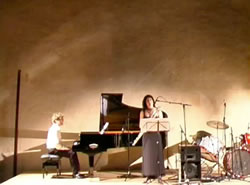

Mach Sieben (2000), for piano, tape, and video

Mach Sieben is my first audiovisual piece. It is a musical palindrome, i.e. the same backwards and forwards. Listen to the recording backwards or watch the video backwards and there would be almost no difference. Before the performance a video is shot of the pianist playing the piece. In the recording the pianist not only plays all of the notes in the reverse order, but also performs all of the action backwards. He or she walks on to the stage backwards, and even the way the keys are hit is altered so that when the video is played backwards in the concert it almost looks like the video is being played forwards. In addition, there are a few theatrical interjections (actions inside the piano, taking off the jacket or, in the case of a female pianist, braiding her hair, and some spoken text). Accordingly most of the sounds are also symmetrical. An extremely prolonged chromatic double attack made up of seven pitches gradually becomes denser, through a process in which each of the pitches branches off into an identical faster double attack which can then be transposed (see score at right).
There are seven sections in total, which alternate between passages that are self-contained palindromes and those that are not. The fourth section has to be symmetrical, because its middle is the middle of the entire piece and from this point on everything runs backwards. And so the first and the third part (and accordingly the fifth and the seventh) are not symmetrical, but despite this they contain certain symmetrical elements, such as the Appassionata loop or the seven-note repeated patterns in part 3. These parts are also set apart in that the double attacks are absent. The sequence of events is actually quite easy to follow and the individual parts are recognizable when they are played backwards later in the piece.
In the concert the stage has to be setup so that the video of the piano is projected onto a screen next to the live piano. At first, both players seem to be doing exactly the same thing, although this actually seems to be impossible. Some members of the audience catch what’s going on almost immediately, others need a while, and there are some who believe until the end that everything is played live and that the mirror image is due to the projection technique. This is astounding, because in the course of the piece there are several points where the pattern doesn’t fit. In the first half, for example, the live pianist plays on while the video pianist stops and scratches his head. In the second half the corresponding passage is reversed. And there is a whole series of small inconsistencies. Also, the fast decaying tones of the piano sound fundamentally different when played backwards. In this one aspect, the live and the video part are clearly distinct from one another over the whole course of the piece. This is on the one hand a problem, because it has to be taken into account during the composition that an attack in the live part will come at the end of every sound. To compensate for this the video part in the score and in the concert has to be shifted by the smallest rhythmic value (in this case an eighth note), otherwise it won’t function correctly. But on the other hand, these backward sounds lend the piece its unique sound. The same scenario with a stringed instrument wouldn’t make any sense at all.
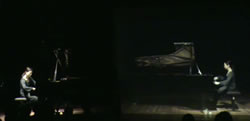



Of course the goal in a performance is to achieve the best possible synchronization between the two players, so that when they don’t align, it is totally clear that this is intentional. This is extremely difficult for the performers. Since 2000, the piece has been played by three pianists (two men and one woman). With the second pianist, I wasn’t able to participate in the video production and the performance did not work very well. The preparatory work with the performers is crucial for the end result and understandably off-putting for many performers. Before recording the video, they already have to know the piece very well (edits are not possible), and they also have to practice things they won’t even need in the concert. In the next step, they have to practice with the video and adapt to their backwards movements. And to make things more complicated, they won’t be able to see the video in the concert. In addition to this, for every new performer, at a bare minimum, the video has to be produced again. With the audio track it is not so obvious which specific player is playing backwards. This all mean a lot of time and effort. As a consolation, the concert poses little difficulty. All that is necessary for the performance is a projector and a good pair of speakers. If the stage is small, it’s fine to rethink the setup of the projection. There have been performances with the pianos back to back, or with a video piano that is much smaller than the live player, and the piano can also be projected onto a wall if necessary. Often this looks better, because the wall is a part of the space.
Doppel (2009), for two grand pianos with live audio and live video
Doppel is my most recent audiovisual piece. Fortunately, in the mean time it has become possible to control complex perfectly synchronized sequences with audio and video using Pd and Graphics Environment for Multimedia (GEM). Earlier attempts with Jitter were unsuccessful, with sound and video that were always out of synch, or delayed starts and other surprises. On top of that, the necessary extension for jitter (Soft-VNS) is notoriously slow in being updated for newer operating systems and Max versions. For the Pd patch (DIVA) used in Doppel, I had the good fortune to get help from Orm Finnendahl and IOhannes Zmölnig. One fantastic feature of DIVA is the possibility to write text scores in delta-time format, which can be loaded into DIVA and the program automises all of the sequences. DIVA is an extremely flexible live sequencer for 100% synchronized audio and video, individually or in tandem. Its basic architecture offers the possibility to work with split screens. This is of course only limited by the computer’s processor speed. HD video won’t be possible for another ten years.
As hinted at above, the phases of the working process for Doppel can be followed by the audience during the performance. The piece is about piano playing, but the piece isn’t meant to present an answer to the question what piano playing is. On the contrary, Doppel is about the process of thinking about what piano playing means. So Doppel is not so much a fixed piece as a documentation of how it came to be.

The musical material in Doppel is idiomatic for the piano: scales, passages, chords and repeated notes (see score at right). The beginning of the piece illustrates how decisions about musical material have been made and how two types of material have been distributed to each pianist.
Over the course of the piece the pianists not only interpret the notated music, which develops gradually from the constellation of material at the beginning, they also slip into a role. Each pianist has material for himself and a task that transcends piano playing. The main visual aspect of Doppel is a result of this. It is not the video, but the pianist who stray just far enough from their usual manner of acting to make the audience aware of their presence and of what they are in fact doing. The video layers in Doppel signify nothing more than the concrete memories which occur while composing music or listening to music. Actually they don’t just remind us of the past and the effects of the past, but they also make clear that a whole network of connotations and associations is activated by the synchronicity of multiple musical events while composing and listening.
Here the point of interest for me is that the momentary impression of the music constructed by the composer is in turn deconstructed by the listener into its components. So the outcome for each listener may significantly differ from the initial situation in the composition intended by the composer. In addition, the mode of perception can be more or less intuitive or intellectual and the resulting discrepancy would — in the field of linguistics — certainly be called a misunderstanding. Considering the fact that in verbal communication a successful understanding between two persons may be regarded as utopian, one should assume that in music it is an impossibility. This dichotomy is the normal case in composed music and a composer has to deal with this situation. In this context, the first question for me is: what happens if the creation of a musical moment can already be experienced as deconstructed? And the other question is: what happens generally to this communication process in the field of art, where a complexity of meanings or significations is presumed even if the artist or composer works with meaningless material in music or without any conceptual intention? The work is done by the listener.
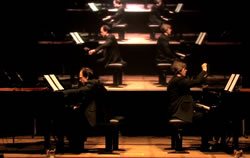

Music Theatre
Finally I’d like to take a short look at my music theatre works. In these works the video is integrated into the conceptual framework of the composition in a different way, and they show, much more clearly than my instrumental music, how my æsthetic stance expresses itself in the music.
Branng! (2005), music theatre for countertenor and 2 actors
The concept for Branng! (2005), music theatre for countertenor and 2 actorscame from the concert presenter and I simply took it as is. The program was an evening of ten music theatre miniatures, which should each last exactly ten minutes, have exactly three performers on the stage, and each piece should cost exactly €10,000. The theme was also set: a large city at night. Together with the director Thierry Bruehl, I developed a subconcept, in which the stipulations of whole project were depicted in our miniature. Our ten minutes was accordingly divided into ten separate sections of a minute each, the music was derived exclusively from the Queen of the Night’s revenge aria, and the text from Rigodon by Louis Ferdinand Céline which describes the bombardment of a major city. And so with this we had taken care of the theme. In the video we see on one side of the screen the elapsed time and on the other side the €10,000 being used up. Everyone sees immediately that the piece will come to an end when we reach a balance of zero euros. The video has no direct connection to the music. The connection is purely conceptual and it is easily understood, because the lights go out every minute during the piece, then the scenic process repeats itself, and the audience realises the connection to the larger process after they have seen the whole concert. In addition, the stage for Branng! is divided into three areas, which again reflect the setup for the whole stage. Specifically, there were three stage containers on a large stage that could be opened one after the other for the individual pieces, while the sets were changed in the neighbouring containers.

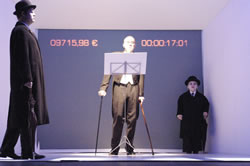
In the front section of our container, a man (Daniel Gloger, countertenor) walks ten times from left to right of the stage (Fig. 1) while trying to sing the Queen of the Night aria. In the middle section, a second man (Hanns Zischler, speaker) was standing in the centre. In the back third of the container, a woman (Monika Ullemeyer, actress), who acted as an observer, wandered a bit further to left every minute, and at the end put a crown on her head. And finally, the performers were lined up according to their height, from tallest to shortest, corresponding to the ceiling of the container which became lower toward the back (Fig. 2).
The nice thing about this setup is its concreteness and simplicity. All of the details relate to the concept for the whole concert as well as the concept for our part. And although this connection is so obvious that the audience is almost hit over the head, it doesn’t seem to hurt the performance, because the concept doesn’t play a role in the action itself. In fact, none of the audience members I spoke to actually realised that none of the music was by me, or that the text was in large part about the glorification of war. No one noticed that the orchestral accompaniment for Daniel Gloger was made up entirely of vocal recordings in a similar manner to the flute version of the string quartet in Die Zwei, even though the Mickey Mouse voices were clearly audible. For me this means: the more concrete and clear or even unambiguous the meaning and signs that are employed, the quicker they lose their original meaning and become a tabula rasa for the listener who is aware of them. And something else becomes clear. A complexity that emerges from a relatively simple musical situation and its different constituent meanings is much more engaging and enjoyable for the listener than a complexity which is already composed into the musical structure.
Why this particular strategy works so well in Branng! is still not completely clear to me. In any case, several factors are vital for the piece to function: that all the quotations come from one piece; the use of very concrete signs which originate from different areas; and finally, that there was a clear relationship to the rest of the concert, which was clearly not just expressed in numbers, but which crucially came to light through the experience of the evening itself. Unfortunately, it’s not really possible to get the full sense of this by watching the live recording of the concert, unless you already know it.
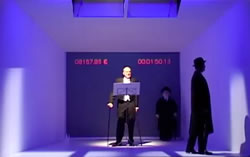

open source (2008) and belle nuit (2009)
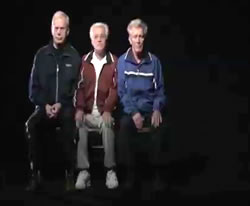

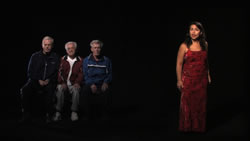
Two more of my music theatre pieces that fit well into this context are open source and belle nuit. These pieces are intimately connected with one another. Both are for the exact same ensemble (solo flute, soprano, string trio, tape and video) and were also part of a collaboration with Thierry Bruehl. In open source, the soprano appears in the video and the flutist on stage, while in the companion piece this is reversed. The prerecorded material is also different to compensate for how the performers are deployed. As was the case in Branng!, the music is based on an aria, here the barcarolle “belle nuit, o nuit d’amore” from Offenbach’s Tales of Hoffmann. In the first half, three older gentlemen in tracksuits (Video 6) are featured in the video and then, depending on which version is being performed, the solo flute or soprano (Fig. 3) appears on stage.
One important element that can’t be seen in the video is that, at the end of the piece, when the aria really begins to pick up steam, several gentlemen, who are distributed throughout the hall, stand up and begin to sway back and forth to the beat of the music. At the premiere in Vienna, some of the audience members even stood up and joined in. At the Berlin premiere of the other version, there was no similar spontaneous display of enthusiasm. The music is actually a gigantic prolongation of the introduction, which is already quite long in the original, and in this way draws out the anticipation of the start of the aria. There isn’t much to say about the effect of the original music. It doesn’t get more apparent than this. My collection of different versions of the aria from various sources (principally YouTube) includes, all told, more than 40 different interpretations and arrangements, from big bands to yoga “accompaniment music”. Part of the strategy for these compositions was to distill these diverse adaptations, which were often made with practical aims in mind and came from very different point of view, into a new piece. It was not supposed to be an arrangement, but it is definitely an expression of my admiration for the barcarolle and its power to effect people. The massive introduction then flows into a wonderful full version consisting of several simultaneously sung original versions in the preferred keys of the individual singers and orchestras, which without a doubt moves in a microtonal direction. I adjusted the lengths of each version so that it is possible to speak of a colla parte on the temporal level.
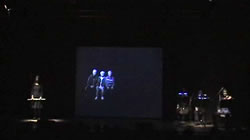

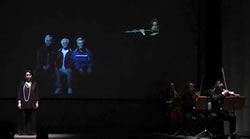

I learned a good deal from both premieres. The most important point was the type of concert where the piece was programed. Pieces, such as these, with theatrical elements will be perceived totally differently in a New Music concert, i.e. with instrumental pieces surrounding it in the program, in comparison to something like Branng! which is featured in a music theatre evening. The audience was in “concert mode”, so to speak, and afterwards was sharply divided in regards to their appreciation of the work. The New Music specialists had no idea how to respond and the musicians were angry, presumably because they didn’t get to play any difficult stuff. In contrast, others, mostly in Vienna, reacted very positively. The gentlemen in the audience had a great deal of fun with the performance, while the musicians on stage were perplexed by the whole situation. It must be said that in the New Music circles, you can’t really count on the healthy sense of humour necessary for these kind of pieces to work. This was especially true for the concert presenter who I was working with in Berlin. At first he refused to pay my commission, because in his view I had not written the music. And he had to play the piece himself in the performance, because the musicians refused to play it. This is of course sad and telling. On the other hand it was a shock for me that a piece like belle nuit is able to cause such a stir these days. This kind of reaction was common among professional musician 30 years ago. Today no orchestra would refuse to play Lachenmann, but a specialist ensemble for New Music refuses to play a deconstructed version of Offenbach.
Social top